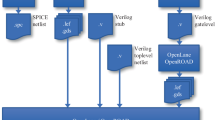Abstract
This paper presents a COordinate Rotation DIgital Computer (CORDIC)-based architecture of the sliding discrete Fourier transform (SDFT) for the real-time spectrum analysis with a refreshing mechanism through which the design can provide reduced and bounded error-accumulation due to the recursive nature of the existing SDFT algorithms. The proposed design is scalable with the transform length and the calculable number of the DFT bins, and can provide high throughput for a single bin evaluation. The paper also presents the comparison of the conventional and the modulated SDFT architectures based on CORDIC algorithm in terms of the angle-approximation and the truncation errors. The proposed design is synthesized on the Xilinx Virtex-6 FPGA platform and is implemented in ASIC using 90 nm standard cell library.








Similar content being viewed by others
References
J.L. Aravena, Recursive moving window DFT algorithm. IEEE Trans. Comput. 39(1), 145–148 (1990)
A. Banerjee, A.S. Dhar, S. Banerjee, FPGA realization of a CORDIC-based FFT processor for biomedical signal processing. Microprocess. Microsyst. 25(3), 131–142 (2001)
K. Duda, Accurate, guaranteed stable, sliding DFT, in Streamlining Digital Dignal Processing: A Tricks of the Trade Guidebook, 2nd edn., ed. by R.G. Lyons (Wiley, Hoboken, 2012), pp. 207–214
A.G. Exposito, J.A.R. Mascias, Fast non-recursive computation of individual running harmonics. IEEE Trans. Circuits Syst. II Analog Digit. Signal Process. 47(8), 779–782 (2000)
J.H. Halberstein, Recursive complex Fourier analysis for real-time applications. Proc. IEEE Lett. 54(6), 903–903 (1966)
Y.H. Hu, CORDIC-based VLSI architectures for digital signal processing. IEEE Signal Process. Mag. 9(3), 16–35 (1992)
Y.H. Hu, The quantization effects of the CORDIC algorithm. IEEE Trans. Signal Process. 40(4), 834–844 (1992)
E. Jacobsen, R. Lyons, Sliding spectrum analysis, in Streamlining Digital Dignal Processing: A Tricks of the Trade Guidebook, 2nd edn., ed. by R.G. Lyons (Wiley, Hoboken, 2012), pp. 175–188
D.C. Kar, V.V.B. Rao, A CORDIC-based unified systolic architecture for sliding window applications of discrete transforms. IEEE Trans. Signal Process. 44(2), 441–444 (1996)
V.Y. Krakovsky, Moving-window discrete Fourier transform. J. Real Time Image Process. 1(2), 153–161 (2006)
T. Kulshreshtha, A.S. Dhar, CORDIC-based Hann windowed sliding DFT architecture for real-time spectrum analysis with bounded error accumulation. IET Circuits Devices Syst. 11(5), 487–495 (2017)
D. Liu et al., Computationally efficient architecture for accurate frequency estimation with Fourier interpolation. Circuits Syst. Signal Process. 33(3), 781–797 (2014)
K.G.R. Liu et al., Optimal unified architectures for the real-time computation of time-recursive discrete sinusoidal transforms. IEEE Trans. Circuits Syst. Video Technol. 4(2), 168–180 (1994)
Y. Liu, L. Fan, T. Ma, A modified CORDIC FPGA implementation for wave generation. Circuits Syst. Signal Process. 33(1), 321–329 (2014)
J.A.R. Mascias, A.G. Exposito, Efficient moving window DFT algorithms. IEEE Trans. Circuits Syst. II Analog Digit. Signal Process. 45(2), 256–260 (1998)
C.S. Park, S.J. Ko, The hopping discrete Fourier transform. IEEE Signal Process. Mag. 31(2), 135–139 (2014)
K.C. Ray, A.S. Dhar, CORDIC-based unified VLSI architecture for implementing window functions for real-time spectral analysis. IEE Proc. Circuits Devices Syst. 153(6), 539–544 (2006)
K.C. Ray, CORDIC-Based VLSI Architectures for Real-Time Digital Signal Processing. Ph.D. thesis, Indian Institute of Technology, Kharagpur (2008)
B.G. Sherlock, D.M. Monro, Moving discrete Fourier transform. IEE Proc. F Radar Signal Process. 139(4), 279–282 (1992)
J. Villalba, T. Lang, E. Zapata, Parallel compensation of scale factor for the CORDIC algorithm. J. VLSI Signal Process. 19(3), 227–241 (1998)
J.-M. Wang, W.F. Eddy, Parallel algorithm for SWFFT using 3D data structure. Circuits Syst. Signal Process. 31(2), 711–726 (2012)
Q. Wang, X. Yan, K. Qin, High-precision, permanently stable, modulated hopping discrete Fourier transform. IEEE Signal Process. Lett. 22(6), 748–751 (2015)
Author information
Authors and Affiliations
Corresponding author
Rights and permissions
About this article
Cite this article
Kulshreshtha, T., Dhar, A.S. CORDIC-Based High Throughput Sliding DFT Architecture with Reduced Error-Accumulation. Circuits Syst Signal Process 37, 5101–5126 (2018). https://doi.org/10.1007/s00034-018-0810-z
Received:
Revised:
Accepted:
Published:
Issue Date:
DOI: https://doi.org/10.1007/s00034-018-0810-z




